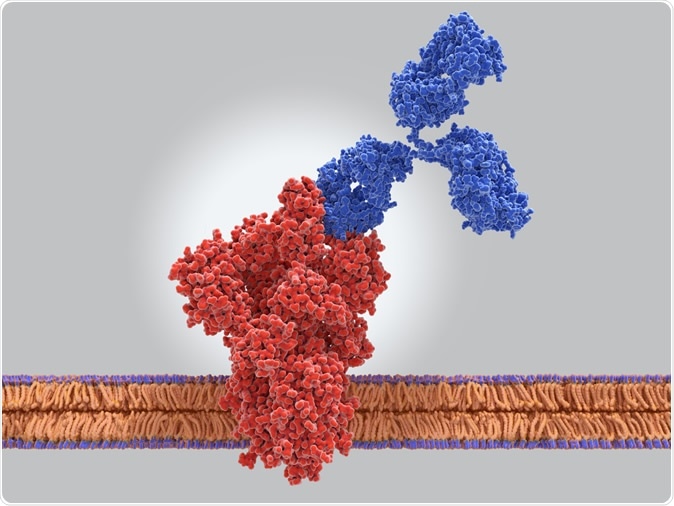The coronavirus disease (COVID-19) has spread to 184 countries and territories. Currently, there is no vaccine available for COVID-19 disease, or SARS-CoV-2 infection. However, scientists around the world are racing to find ways to block the virus.
Now, a team of international scientists is looking at a promising vaccine candidate that was created to deal with Middle East Respiratory Syndrome (MERS) caused by MERS coronavirus (MERS-CoV). Middle East Respiratory Syndrome (MERS) is a disease similar to COVID-19 that emerged in 2012 in Saudi Arabia. During the MERS outbreak, more than 850 people died. MERS had a high fatality rate of 30 percent.
.jpg)
MERS Virus Particles Colorized scanning electron micrograph of Middle East Respiratory Syndrome virus particles (yellow) attached to the surface of an infected VERO E6 cell (blue). Image captured and color-enhanced at the NIAID Integrated Research Facility in Fort Detrick, Maryland. Credit: NIAID
Published in mBio, the official journal of the American Society of Microbiology, the study shows the promise of a new intranasal vaccine using an RNA virus for gene delivery, which can protect people against the fatal MERS-CoV infections in mice.
Promising MERS vaccine candidate
The MERS-CoV has a higher fatality rate than the SARS-CoV-2 infection, which has about 2 to 3 fatality rates on average. However, in some countries, the fatality rate is higher.
The researchers believe that the novel approach that was used to develop a MERS virus vaccine may also work against the novel SARS-CoV-2, which is wreaking havoc across populations as it infects more than 1.5 million people and has killed nearly 90,000 people.
The vaccine has a unique delivery method through an RNA virus known as the parainfluenza virus 5 (PIV5), simian virus 5 (SV5), which is known to cause kennel cough in dogs. The virus is deemed harmless in people. For the virus to produce the S, or spike, a glycoprotein tied to MERS infections, the scientists added a new gene to the virus.
“We know people have been exposed to PIV5, but it seems to be an innocuous virus in humans. PIV5 doesn’t seem to cause a cytopathic effect,” Dr. Paul McCray, a pediatric pulmonologist and coronavirus expert at the University of Iowa, in Iowa City, said.
Since the MERS virus cannot reproduce in mice, the team developed a mouse model by genetically engineering them to be susceptible to the MERS virus. The mice are engineered to express the DPP4, a protein utilized by the MERS virus as an entry point in human cells.
Laboratory experiments showed that even a single dose of the vaccine, taken intranasally, effectively caused the infected cells to produce the S protein that can kick start an immune response against the protein in the mice.
After one month of receiving the vaccine, the researchers exposed the mice to a MERS virus strain to cause infection. Another group of mice who did not receive the vaccine, but received a different PIV5 vaccine that has no genes for S protein or an inactivated MERS virus is given intramuscularly, were also exposed to the virus.
When given the promising novel vaccine, all the mice who received it survived MERS, while the mice that had not received the vaccine did not. Meanwhile, the mice that received the inactivated MERS virus only had 25 percent of protection from the fatal infection.
“Our work demonstrates that PIV5 is a promising vector for developing a MERS vaccine. Furthermore, the success of the PIV5-based MERS vaccine can be employed to develop a vaccine for emerging coronaviruses such as SARS-CoV-2, which causes COVID-19,” the researchers concluded in the study.
Same strategy for COVID-19
With the promising results for MERS-CoV, the researchers plan to apply the same strategy to develop a vaccine for SARS-CoV-2, the virus that causes COVID-19. The researchers are now taking the same path toward developing a new vaccine to protect against COVID-19.

Theoretical antibody binding to the spike (S) protein of the coronavirus SARS-CoV-2. Image Credit: Juan Gaertner / Shutterstock
“We’re quite interested in using viruses as gene delivery vehicles,” said Dr. McCray.
Finding an effective vaccine for COVID-19 is a race against time. Dr. McCray said that though the novel coronavirus can infect many people of the whole population, not all will be exposed. In the advent that the virus reemerges in the future, more people will be infected. It is crucial to develop a vaccine to protect people against the illness, providing lasting immunity from the SARS-CoV-2 infection.
The United States has the highest infection toll, with more than 430,000 people infected, while Italy reports the highest death toll, with 17,669 deaths.
Sources:
Journal reference:
- Li, K., Li, Z., Wohlford-Lenane, C., Meyerholz, D., Channappanavar, R., An, D., Perlman, S., McCray, P., and He, B. (2020). Single-Dose, Intranasal Immunization with Recombinant Parainfluenza Virus 5 Expressing Middle East Respiratory Syndrome Coronavirus (MERS-CoV) Spike Protein Protects Mice from Fatal MERS-CoV Infection. mBio. https://mbio.asm.org/content/11/2/e00554-20